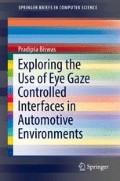Abstract
The previous chapters demonstrate that it is possible to control on-board infotainment systems in a car using gaze-controlled interface and an off-the-shelf eye gaze tracker can also be used to detect sudden change in drivers’ cognitive load. So how far are we from installing gaze-controlled interface in a real car? The following paragraphs point out limitations of existing technology and also points to future research directions.
Access this chapter
Tax calculation will be finalised at checkout
Purchases are for personal use only
References
Biswas P (2014) Inclusive human machine interaction for India, Springer, ISBN 978-3-319-06165-8
Biswas P, Langdon P (2011) A new input system for disabled users involving eye gaze tracker and scanning interface. J Assist Technol 5(2) June 2011, ISSN: 1754–9450
Biswas P, Langdon P (2012) Developing multimodal adaptation algorithm for mobility impaired users by evaluating their hand strength. Int J Hum Comput Interact 28(9), Taylor & Francis, Print ISSN: 1044–7318
Biswas P, Langdon P (2015) Multimodal intelligent eye-gaze tracking system. Int J Hum Comput Interact 31(4), Taylor & Francis, Print ISSN: 1044–7318
Biswas P, Langdon P, Umadikar J, Kittusami S, Prashant S (2014) How interface adaptation for physical impairment can help able bodied users in situational impairment. In: Inclusive designing – joining usability, accessibility, and inclusion, Springer, New york
Farrell S, Zhai S (2005) System and method for selectively expanding or contracting a portion of a display using eye-gaze tracking, US Patent No.: 20050047629 A1
Author information
Authors and Affiliations
Rights and permissions
Copyright information
© 2016 Springer International Publishing Switzerland
About this chapter
Cite this chapter
Biswas, P. (2016). Concluding Remarks. In: Exploring the Use of Eye Gaze Controlled Interfaces in Automotive Environments. SpringerBriefs in Computer Science. Springer, Cham. https://doi.org/10.1007/978-3-319-40709-8_7
Download citation
DOI: https://doi.org/10.1007/978-3-319-40709-8_7
Published:
Publisher Name: Springer, Cham
Print ISBN: 978-3-319-40708-1
Online ISBN: 978-3-319-40709-8
eBook Packages: Computer ScienceComputer Science (R0)

